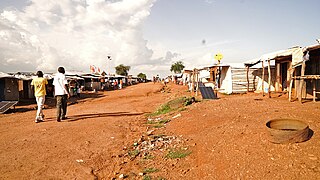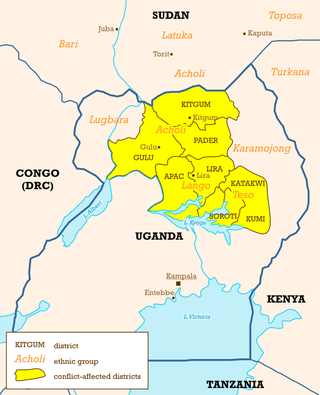Related Research Articles
Sudanese refugees are people originating from the country of Sudan, seeking refuge outside the borders of their native country. In recent history, Sudan has been the stage for prolonged conflicts and civil wars, as well as environmental changes, namely desertification. These forces have resulted not only in violence and famine but also the forced migration of large numbers of the Sudanese population, both inside and outside the country's borders. Given the expansive geographic territory of Sudan, and the regional and ethnic tensions and conflicts, much of the forced migration in Sudan has been internal. Yet, these populations are not immune to similar issues that typically accompany refugeedom, including economic hardship and providing themselves and their families with sustenance and basic needs. With the creation of a South Sudanese state, questions surrounding southern Sudanese IDPs may become questions of South Sudanese refugees.

By January 2011 the United Nations High Commissioner for Refugees (UNHCR) estimated that there are 262,900 Sudanese refugees in Chad. The majority of them left Sudan escaping from the violence of the ongoing Darfur crisis, which began in 2003. UNHCR has given the Sudanese refugees shelter in 12 different camps situated along the Chad–Sudan border. The most pressing issues UNHCR has to deal with in the refugee camps in Chad are related to insecurity in the camps, malnutrition, access to water, HIV and AIDS, and education.

Education in South Sudan is modelled after the educational system of the Republic of Sudan. Primary education consists of eight years, followed by four years of secondary education, and then four years of university instruction; the 8 + 4 + 4 system, in place since 1990. The primary language at all levels is English, as compared to the Republic of Sudan, where the language of instruction is Arabic. There is a severe shortage of English teachers and English-speaking teachers in the scientific and technical fields.

Rhino Camp Refugee Settlement is a refugee camp located in the districts of Madi-Okollo and Terego District in North Western Uganda.
Pagirinya Refugee Settlement is a refugee camp in Eastern Adjumani District in Northern Uganda.

In the early months of 2017, parts of South Sudan experienced a famine following several years of instability in the country's food supply caused by war and drought. The famine, largely focused in the northern part of the country, affected an estimated five million people. In May 2017, the famine was officially declared to have weakened to a state of severe food insecurity.

Bidibidi Refugee Settlement is a refugee camp located in Yumbe District's West Nile sub-Region in Uganda. It is one of the world’s largest refugee settlements, housing approximately 285,000 refugees fleeing conflict in South Sudan as of late 2016. In 2017, and refugees from DR Congo. it was described as the largest refugee settlement site in the world, and in 2023, it was labeled "Africa’s largest refugee camp" by The Guardian.

Uganda is one of the largest refugee-hosting nations in the world, with 1,529,904 refugees. The vast influx of refugees is due to several factors in Uganda's neighboring countries, especially war and violence in South Sudan and the Democratic Republic of the Congo, and associated economic crisis and political instability in the region. Uganda has relatively 'friendly' policies that provide rights to the refugees, such as rights to education, work, private property, healthcare and other basic social services.
Imvepi Refugee Settlement is a refugee camp in Terego District in West Nile Sub Region of northwestern Uganda.
Nyumanzi Refugee Settlement is a refugee camp in Adjumani District in northwestern Uganda. Established in 2014, it hosts about 52,000 South Sudanese refugees.
The Palorinya Refugee Settlement is a refugee camp in the Moyo District of the Northern Region of Uganda. The majority of the population fled the civil crisis in South Sudan in 2016.
Mungula II Refugee Settlement is a refugee camp found in Adjumani District Itirikwa subcounty in Northern Uganda.
Olua I Refugee settlement is a refugee camp in eastern Adjumani District in Northern Uganda. The Refugee settlement has its primary country as Uganda and other country south Sudan.
Mirieyi refugee settlement is a refugee camp in Ofua Sub County in the Adjumani District of Uganda.

Boroli refugee settlement is a refugee camp located in the Pakele Sub County of Adjumani District Northern Region, of Uganda.
Ayilo 2 refugee settlement is one of the refugee camps in Adjumani District in the Northern Region of Uganda.
The Agojo refugee settlement is a refugee camp in the Adjumani District of Northern Uganda, opened in 2016 in response to an influx of South Sudanese refugees fleeing the insecurity in their country. It is located 16 kilometres (10 mi) west of the town of Adjumani.

The Maaji refugee settlements are three refugee camps located in Adjumani District in the Northern Region of Uganda, established in 1997. In June 2018, there were 41,764 registered refugees, accounting for 10% of the district's total population. It has primarily admitted refugees from the Second Sudanese Civil War and the ongoing South Sudanese Civil War. The settlements have been attacked several times by the Lord's Resistance Army, along with other camps in the region such as the Baratuku refugee settlement.
Rhino Camp Extension Refugee settlement is a refugee camp located in Omugo Zone in Arua District in Uganda. It is also known as Rhino Refugee camp - Omugo zone Extension. It hosts over 43,000 refugees. It is located next to the Imvepi Refugee Settlement.
Ayilo 1 refugee settlement is a prominent refugee camp located in Adjumani District, situated in the Northern Region of Uganda.
References
- ↑ "Uganda Refugee Response Monitoring Settlement Fact Sheet: Mungula (June 2018)". relief web. 2019-06-02. Retrieved 2020-09-19.
- ↑ "South Sudan profile - Timeline". BBC. 2018-08-06. Retrieved 2020-09-19.
- ↑ "Timeline: South Sudan since independence". Aljazeera. 2020-02-22. Retrieved 2020-09-19.
- ↑ Ayebale, Reachel (2018-09-18). "Mungula Health Center IV sets up a Blood Transfusion Centre". open enabel. Retrieved 2020-09-19.
- ↑ Nakibuka Mbonye, Proscovia (2020-04-01). "Communities name water tap 'Women's Freedom'". Unicef Uganda.
- ↑ Kyatuka, Derrick (2018-05-16). "Mungula refugee camp gets classroom boost". New vision. Retrieved 2020-09-19.
- ↑ "Mungula secondary School". Uganda schools guide. Retrieved 2020-09-19.
- 1 2 Schmidt, Lauren (2014-10-01). Agency of the South Sudanese: Compensating for Health Care in Mungula Refugee Settlement. SIT Digital Collections. OCLC 903717738.
- ↑ Miyamoto, Kenta (2020-04-09), "Challenges, Perceptions, and Practices in Education for South Sudanese Children Forced to Flee Conflict", Migrants and Comparative Education, Brill | Sense, pp. 205–224, doi:10.1163/9789004417014_012, ISBN 978-90-04-41701-4 , retrieved 2020-09-23
- 1 2 "Uganda Refugee Response Monitoring Settlement Fact Sheet: Mungula (June 2018)". Relief web. 2019-02-06. Retrieved 2020-09-19.
- ↑ "Refugees to produce their own food". PML Daily. 2018-07-07. Retrieved 2020-09-19.